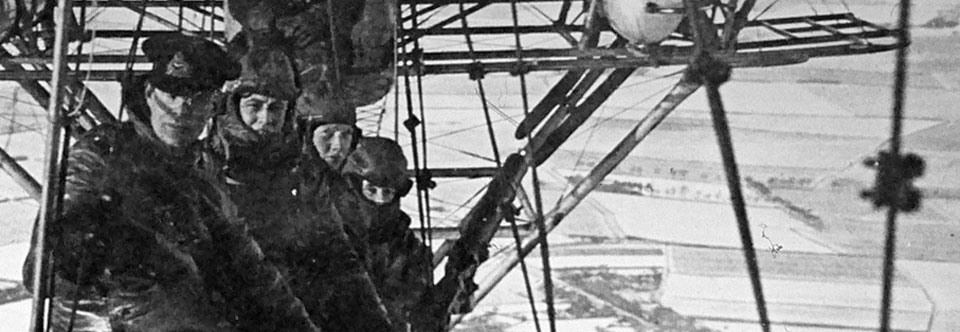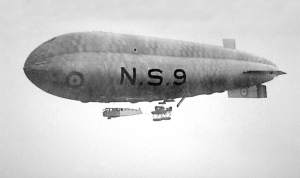
By P. E. Maitland
“Just over a month after the loss of NS3, I was given command as Captain of my own ship, NS9, on 28th July, 1918. My Second Officer was Cpt. S.B.Harris and I had a completely new crew apart from LAC Davis, who had been W/T operator on NS3. My new command passed its trial flight, which lasted six hours forty-five minutes, on 28th, followed by speed trials and acceptance test on 29th. All went very well, and on 31st July, we flew NS9 north from Kingsnorth to her new station at Longside, the trip lasting eleven hours and twenty minutes.
With the arrival in service of more North Sea airships the tempo of anti-submarine operations increased, as did the strength of the airship escorts to the coastal convoys. In addition, several special operations took place in conjunction with specialised submarine hunting units.
Explosive nets were laid across the expected tracks of home-coming German submarines, and were watched by hydrophone-carrying surface craft, and, when possible, by airships. On the other hand the German U-boats now carried heavier guns, and when returning home were more inclined to keep on the surface.
On 31st July 1918, C25, commanded by Captain Hopperton, RAF, had been sunk in this way. The Germans never claimed to have attacked or destroyed C25, but it was the opinion at Longside that this was in fact the case. No airship was attacked, however, while with a convoy, for by so doing the U-boat would have given away her own position.
On 13th August, when patrolling off the Aberdeen coast in hazy weather, NS9 was also shot at. When visiting the engineers I noticed eight shell bursts near the tail fin, and realised that we were being fired at. By the time I had regained the control position and got both engines running at full speed and the ship turned towards the area, the firing had stopped. No-one was able to see the U-boat or the gun flash because of the haze. NS6 joined in the search, but neither airship saw any sign of the submarine.
On thinking it over afterwards we realised that it was one thing to surprise a U-boat surfacing, and another to approach one already on the surface with guns manned. We should have had an anxious time approaching as our 269 ft length would be hard to miss at a range of 900 feet. We did not have any opportunity of testing that!
During September we and the other airships were busy on patrols, usually of twelve hours although I did three of over sixteen hours in NS9. In mid-September we had occasion to realise that even the newer NS airships were not immune from all the troubles of the older ships. What occurred will give some idea of what patrolling meant.
We had been out on patrol to the north-eastward out of sight of land, and were returning in the late afternoon. It had been a day of fresh blustering winds from the north east and the wind having backed to the south west, we were plugging back into a head wind. Our speed over the sea was obviously getting slower. Presently it became clear that unless the wind dropped we would have a very long journey home, and that there was no alternative base nearer than Norway. We hopped that our navigational errors of the past nine hours were not too great and looked forward to the time when we should sight land. We had increased speed to three-quarters power which gave an airspeed of 50 mph, and we were probably making about 25 mph over the sea and less in squalls. However, at 800 feet the air was fairly steady and the ship was handling easily except that the coxswain seemed to have difficulty in keeping the ship on course. Every time she swung off course the sea no longer moved behind us but just moved sideways. If this continued our trip homeward was going to be very long indeed.
At length the coxswain reported that the steering was getting stiffer and stiffer, and that he could hardly control the rudder. There was no alternative method of steering and it might take some time to find and rectify the fault, if it could be got at. If we let the ship get side to wind we would be drifting away from home faster than we had been approaching it before. Luckily, in the ‘spares bag’ we had two small blocks and tackle known in the navy as ‘Handy Billy’. By securing one to each rudder control in the cabin with a man on each, after some practice we managed to steer fairly well.
The engineer found that the bearing of the steering wheel had seized up, but fortunately he could get at it and hoped to be able to strip it down and free it in a short time. After a rather anxious period when our progress over the sea became slower and the gusts more frequent, he completed the job and we were able to dispense with our makeshift steering arrangements. By this time it was blowing hard so we increased to full speed which used up fuel fast, and we came down to about 100 feet over the sea in the hope that the wind might be slightly less, close to the waves.
Time went by slowly. The W/T operator was able to get a rough position from the Direction Finding (D/F) stations which tended to confirm our own idea of our position. Then the engineer came forward to ask which petrol tank was to be used next. This was important because it was desirable to keep the weights in the ship adjusted so that the trim was neither too nose nor too tail heavy. The report rubbed in that with the engines at full speed we were using petrol fast – pity that we had not filled right up with petrol, but then that would have meant one less bomb. Anyway, there was nothing we could do about it now. The urge to bother about our petrol consumption and how much we had left must be checked. After all, we were doing our best.
The next half-hour dragged by. Then to our relief the clouds above us thinned, the sea seemed less rough and the wind started to drop. Soon the sun came out and in the distance there was a faint blur on the horizon which gradually grew into the familiar landmark of Mormon Hill. Our navigation had been all right after all. The crew were all smiles again. The black cliffs of Peterhead harbour passed underneath. We were soon successfully landed and the airship back in its shed again.
Finally, on 21st September we had been out on a long patrol during which we sighted a mine adrift off Aberdeen. We had this sunk by a trawler. We were then recalled as the wind was rising rapidly from the south east. On arrival we found that C15 and NS10 were circling waiting to land, while the landing party of some 300 men were having great difficulty in controlling C7 which was dragging about in the eddies at the entrance of the shed. By that time the squalls were reaching 45 mph and it was clear that we should have difficulty in getting down and into the shed. There was no shelter in the desolate hill country in which we could have moored, and no other station which we could reach.
At last we saw that C7 had been ripped. With reasonable luck little damage need be done and the ship could be repaired. C15 was also ripped soon after landing, and an effort was then made to dock the much larger NS10. This proved extremely hazardous and from the air we could see the ship swaying and plunging: one moment the car was twenty feet off the ground, and the next dashed to earth. The airmen on the handling guys were being carried off their feet, and were hanging on like grim death. This often took considerable courage even with an experienced team, in a struggle with a gale. Landing parties took great pride in it, and as Longside was in an exposed position there were often high winds, so the landing party had plenty of practice.
NS10 was ripped, and then it was our turn. We landed without too much difficulty, but once in the lee of the sheds the ship became unmanageable in the down drafts and back eddies. After some particularly fierce squalls when the airship envelope crashed down on the car and the 300 men were dragged hither and thither, we regretfully ripped our ship too, clear of the remains of the other three.
So ended for the moment the activities of NS9 and NS10 – a depressing sight on a rain-swept evening, with the silvery grey shapes of the four ships sprawled out on the trampled mud, and here and there the cars of the airships, standing in the wreckage. However, we knew that given time they could be repaired and that two new NS ships were being completed.”
From notes written by Air Vice Marshall P. E. Maitland and given to the author Brian Turpin.
Thanks again to Brian Turpin for generously allowing us to publish this article.



 NS11 – As Bright As Day is very much a work in progress and has been made possible by the generous and enthusiastic support of many individuals and organisations. If you have any information, records or material relating to British NS Class airships we would be very interested to hear from you – especially anyone related to members of the crew of NS11 or any airship of the class during their service with the RNAS or RAF during and beyond WWI.
NS11 – As Bright As Day is very much a work in progress and has been made possible by the generous and enthusiastic support of many individuals and organisations. If you have any information, records or material relating to British NS Class airships we would be very interested to hear from you – especially anyone related to members of the crew of NS11 or any airship of the class during their service with the RNAS or RAF during and beyond WWI.
Latest